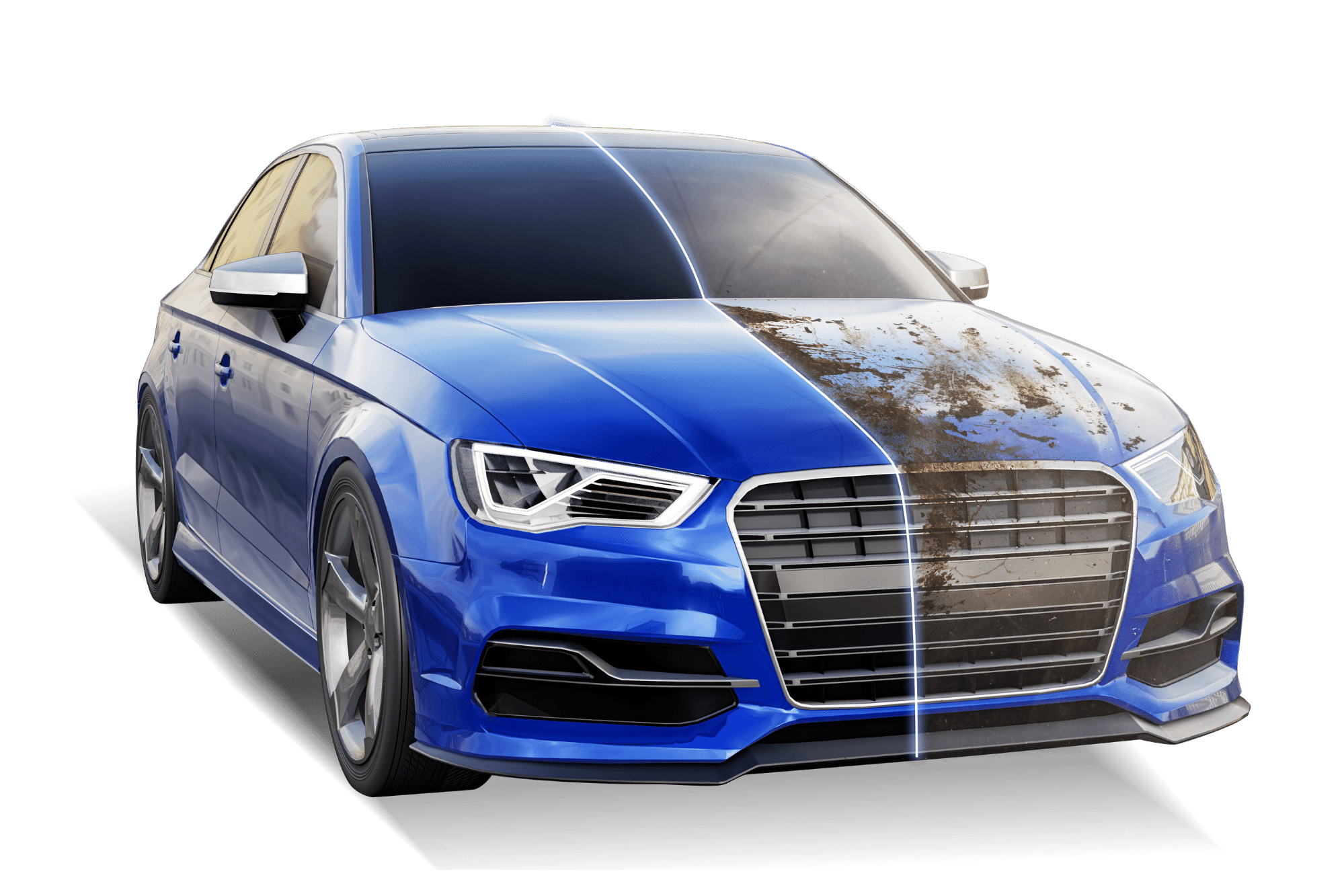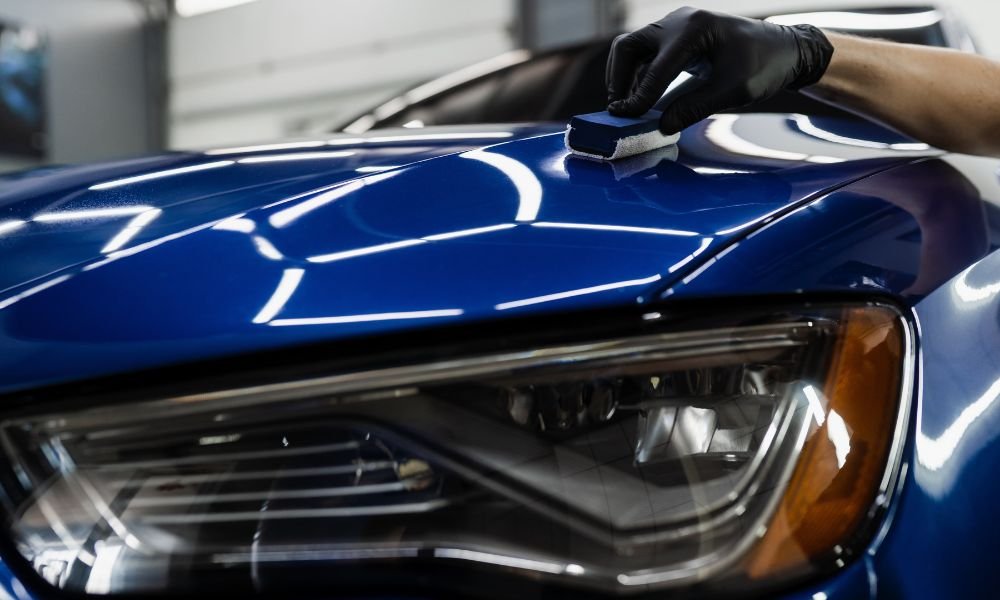A detailed guide to choosing the ideal Ceramic Coating Newark service
Checking out the Science Behind Car Ceramic Coating and Its Safety Characteristics
The scientific research of car ceramic coating offers an interesting study in advanced auto security. Composed largely of silicon dioxide and polymers, these finishes form a durable bond with automobile paint. This communication boosts toughness against ecological dangers while offering hydrophobic benefits. The details of just how these coatings work and their long-lasting advantages remain much less recognized. Ceramic Coating Newark. Unboxing these information discloses why ceramic layers are coming to be a preferred selection for automobile treatment
What Is Ceramic Coating?
Ceramic coating is a liquid polymer that chemically bonds to the surface of an automobile's paint. This sophisticated protective layer boosts resilience and offers superior resistance to ecological aspects. Unlike conventional wax or sealants, which give momentary security, ceramic coatings develop a durable guard that can endure harsh problems such as UV rays, acidic pollutants, and extreme weather. When used appropriately, the coating develops a hydrophobic surface, causing water to grain and slide off, which aids in preserving the car's sanitation. Furthermore, it provides enhanced gloss and deepness to the paint, making the vehicle show up more sleek and vivid. The application procedure normally entails detailed surface prep work, including cleansing and sprucing up, to ensure peak bonding. As an outcome, ceramic coverings are coming to be significantly popular among car lovers and those seeking to safeguard their investments, assuring to maintain the automobile's aesthetic charm while lowering the frequency of upkeep.
The Composition of Ceramic Coatings
The intricate formulation of ceramic coverings primarily consists of silicon dioxide (SiO2), which is acquired from all-natural sources like quartz and sand. This crucial part provides the foundation for the coating's longevity and protective high qualities. In enhancement to SiO2, ceramic coatings often include various polymers and additives that improve attachment, flexibility, and resistance to environmental aspects. These compounds work synergistically to develop a robust obstacle against pollutants such as dust, chemicals, and UV rays.Furthermore, some formulations integrate titanium dioxide (TiO2) or other nanomaterials, which can enhance the coating's hydrophobic properties, leading to enhanced water repellency. The accurate structure can vary substantially amongst manufacturers, affecting performance and longevity. Inevitably, the mix of these components finishes in a safety layer that not just improves the aesthetic appeal of cars but also serves to prolong their life expectancy by shielding the surface from prospective damages.
Exactly How Ceramic Coatings Work
Recognizing just how ceramic layers function involves exploring their chemical make-up, which adds to their safety qualities. The application procedure is essential for attaining excellent outcomes, while durability and durability aspects determine the coating's efficiency over time. Together, these components highlight the benefits and performance of ceramic coverings for vehicle defense.
Chemical Structure Explained
While many car proprietors seek long-lasting protection for their lorries, the chemical structure of ceramic finishings plays a vital role in their efficiency. These coatings mostly consist of silicon dioxide (SiO2), which is stemmed from all-natural minerals. This compound creates a solid bond with the car's paint, producing a durable, protective layer. Furthermore, lots of ceramic layers contain titanium dioxide (TiO2), enhancing their hydrophobic homes and resistance to UV rays. The presence of polysiloxanes can further enhance flexibility and resilience. Together, these aspects contribute to the coating's capability to drive away water, dirt, and contaminants, while also supplying a high-gloss surface. Understanding this chemical structure aids car proprietors value the durable protection offered by ceramic coatings.
Application Process Introduction
Using ceramic coverings includes a thorough process that assures ideal bonding and security for the automobile's surface area. Originally, comprehensive cleansing and decontamination of the car's outside are done to eliminate dirt, crud, and previous waxes. This step validates that the surface area is without impurities that could hinder adhesion. Following this, the paint is commonly brightened to boost quality and get rid of any kind of blemishes. When prepared, the ceramic coating is applied in little sections making use of an applicator pad, enabling consistent protection. The coating is after that delegated cure, forming a solid chemical bond with the surface area. Appropriate curing times and problems are crucial, as they validate the coating accomplishes its maximum performance and protective qualities.
Long Life and Longevity Factors
Ceramic coatings are created to provide long-lasting protection with their innovative chemical make-up, which produces a robust barrier against environmental impurities. The toughness of these coatings is affected by factors such as the density of the application, the high quality of the item, and the problems under which the vehicle is subjected. High-quality ceramic coatings can last several years, standing up to scrapes, UV rays, and chemical spots. Proper upkeep, consisting of routine cleaning and regular reapplication, can even more improve durability. Furthermore, environmental aspects like climate and direct exposure to toxins can influence the lifespan of the coating. On the whole, when used and preserved correctly, ceramic coatings use phenomenal durability, making them a popular choice for car enthusiasts looking for to protect their automobile's look.
Hydrophobic Characteristics and Water Repellency
Hydrophobic properties are a characteristic of high quality car ceramic finishes, substantially improving the car's surface performance. These coatings create a molecular bond with the car's paint, leading Going Here to a surface area that wards off water successfully. When water enters call with a ceramic-coated surface, it beads up and rolls off, lessening the quantity of fluid that stays on the paint. This actions not only adds to a cosmetically pleasing appearance yet also decreases the build-up of contaminants such as dirt, gunk, and roadway salts.The improved water repellency leads to much easier cleansing and upkeep, as much less effort is required to get rid of undesirable materials. Furthermore, the hydrophobic nature of ceramic coverings assists in avoiding water spots, which can mar the finish of uncoated surface areas. In general, the unification of hydrophobic homes in ceramic layers plays a necessary function in keeping the lorry's immaculate look while simplifying upkeep.
Defense Versus Scratches and UV Damages
Car ceramic finishings offer considerable defense against scratches and UV damage. The scratch resistance system produces a durable layer that takes in influences, while the UV protecting advantages assist preserve the car's paint stability gradually. Together, these attributes add to a longer-lasting and aesthetically enticing surface.
Damage Resistance Mechanism
Using innovative innovation, ceramic layers provide a durable shield versus scrapes and UV damage, enhancing the durability and look of vehicle surface areas. The scratch resistance mechanism of these coatings is credited to their distinct molecular framework, which forms a sturdy bond with the car's paint. This bond creates a hard, safety layer that can take in influences and stand up to abrasions. In addition, the smooth surface area of the coating reduces rubbing, making it tough for impurities to stick and cause scratches. The chemical make-up of ceramic coatings commonly consists of nanoparticles that enhance the protective layer, further enhancing its resilience. Vehicles treated with ceramic coverings display substantially improved scratch resistance contrasted to typical wax or sealers, making sure a beautiful finish over time.
UV Protecting Perks
The protective qualities of ceramic finishes prolong beyond scratch resistance visit their website to include considerable UV protecting advantages. These coatings create a durable obstacle that mirrors unsafe ultraviolet rays, protecting the vehicle's paint and underlying materials. Long term exposure to UV radiation can bring about fading, oxidation, and deterioration of the paint coating. By incorporating ceramic coverings, automobile owners can effectively minimize these dangers, preserving the visual charm and stability of their vehicles. Additionally, the UV obstructing residential or commercial properties add to improved durability, minimizing the regularity of repainting and upkeep. Eventually, the integration of ceramic layers supplies a complete remedy for safeguarding lorries from the damaging impacts of sun exposure, making sure a sustained, dynamic appearance over time.
The Durability and Upkeep of Ceramic Coatings

Regularly Asked Questions
Can Ceramic Coating Be Applied to Any Sort Of Lorry?
Ceramic coating can be applied to various types of lorries, including cars and trucks, trucks, and motorbikes. Surface area preparation and compatibility with details materials are important for ideal attachment and efficiency of the coating.
Just How Much Does Ceramic Coating Typically Price?
Ceramic coating usually costs between $500 and $2,000, relying on aspects such as lorry dimension, coating high quality, and professional application. The investment can provide long-lasting defense and improve the automobile's appearance over time.

Is Professional Application Required for Finest Outcomes?
The need of professional application typically depends upon desired outcomes. Professionals normally ensure proper surface prep work and application methods, causing optimal bonding and durability of the coating, which may be challenging for unskilled people to achieve.
Can Porcelain Coatings Be Gotten Rid Of or Fixed?
Ceramic coverings can be removed or fixed, though the procedure might call for certain solvents or methods - Ceramic Coating Newark. Proper removal is vital to prevent damages to the underlying surface, stressing the relevance of expert support for optimal outcomes
Exactly How Does Porcelain Coating Contrast to Traditional Wax?
The contrast in between ceramic coating and conventional wax reveals that ceramic layers offer superior durability, enhanced defense versus ecological pollutants, and longer-lasting luster, while wax needs much more constant application and supplies much less total resistance to damages.